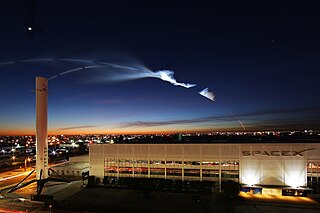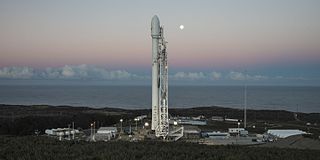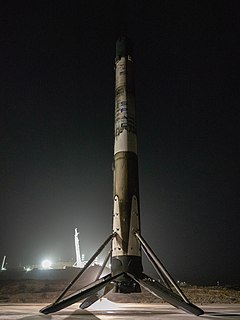
Space Exploration Technologies Corp., trading as SpaceX, is an American aerospace manufacturer and space transportation services company headquartered in Hawthorne, California. It was founded in 2002 by Elon Musk with the goal of reducing space transportation costs to enable the colonization of Mars. SpaceX has developed several launch vehicles, the Starlink satellite constellation, and the Dragon spacecraft.

Falcon 9 is a partially reusable two-stage-to-orbit medium-lift launch vehicle designed and manufactured by SpaceX in the United States. It is powered by Merlin engines, also developed by SpaceX, burning cryogenic liquid oxygen and rocket-grade kerosene (RP-1) as propellants. Its name is derived from the fictional Star Wars spacecraft, the Millennium Falcon, and the nine Merlin engines of the rocket's first stage. The rocket evolved with versions v1.0 (2010–2013), v1.1 (2013–2016), v1.2 "Full Thrust" (2015–present), including the Block 5 Full Thrust variant, flying since May 2018. Unlike most rockets, which are expendable launch systems, since the introduction of the Full Thrust version, Falcon 9 is partially reusable, with the first stage capable of re-entering the atmosphere and landing vertically after separating from the second stage. This feat was achieved for the first time on flight 20 with the v1.2 version in December 2015.

The SpaceX Dragon, also known as Dragon 1 or Cargo Dragon and now superseded by Dragon 2, is a reusable cargo spacecraft developed by SpaceX, an American private space transportation company. Dragon was launched into orbit by the company's Falcon 9 launch vehicle to resupply the International Space Station (ISS).

Vertical takeoff, vertical landing (VTVL) is a form of takeoff and landing for rockets. Multiple VTVL craft have flown. The most widely known and commercially successful VTVL rocket is SpaceX's Falcon 9 first stage.

Space Launch Complex 4 (SLC-4) is a launch and landing site at Vandenberg Air Force Base with two pads, both of which are used by SpaceX for Falcon 9 launch operations; operating as Landing Zone 4 (LZ-4) for SpaceX landings.

The SpaceX reusable launch system development program is a privately funded program to develop a set of new technologies for an orbital launch system that may be reused many times in a manner similar to the reusability of aircraft. SpaceX has been developing the technologies over several years to facilitate full and rapid reusability of space launch vehicles. The project's long-term objectives include returning a launch vehicle first stage to the launch site in minutes and to return a second stage to the launch pad following orbital realignment with the launch site and atmospheric reentry in up to 24 hours. SpaceX's long term goal is that both stages of their orbital launch vehicle will be designed to allow reuse a few hours after return.

SpaceX CRS-8, also known as SpX-8, was a Commercial Resupply Service mission to the International Space Station (ISS) which was launched on April 8, 2016, at 20:43 UTC. It was the 23rd flight of a Falcon 9 rocket, the tenth flight of a Dragon cargo spacecraft and the eighth operational mission contracted to SpaceX by NASA under the Commercial Resupply Services program. The capsule carried over 3,100 kilograms (6,800 lb) of cargo to the ISS including the Bigelow Expandable Activity Module (BEAM), a prototype inflatable space habitat delivered in the vehicle's trunk, which will be attached to the station for two years of in-orbit viability tests.

SpaceX CRS-5, also known as SpX-5, was a Commercial Resupply Service mission to the International Space Station, conducted by SpaceX for NASA, and was launched on 10 January 2015 and ended on 11 February 2015. It was the seventh flight for SpaceX's uncrewed Dragon cargo spacecraft and the fifth SpaceX operational mission contracted to NASA under an ISS resupply services contract.

SpaceX CRS-6, also known as SpX-6, was a Commercial Resupply Service mission to the International Space Station, contracted to NASA. It was the eighth flight for SpaceX's uncrewed Dragon cargo spacecraft and the sixth SpaceX operational mission contracted to NASA under a Commercial Resupply Services contract. It was docked to the International Space Station from 17 April to 21 May 2015.

SpaceX CRS-7, also known as SpX-7, was a private American Commercial Resupply Service mission to the International Space Station, contracted to NASA, which launched and failed on June 28, 2015. It disintegrated 139 seconds into the flight after launch from Cape Canaveral, just before the first stage was to separate from the second stage. It was the ninth flight for SpaceX's uncrewed Dragon cargo spacecraft and the seventh SpaceX operational mission contracted to NASA under a Commercial Resupply Services contract. The vehicle launched on a Falcon 9 v1.1 launch vehicle. It was the nineteenth overall flight for the Falcon 9 and the fourteenth flight for the substantially upgraded Falcon 9 v1.1.

The Falcon 9 first-stage landing tests were a series of controlled-descent flight tests conducted by SpaceX between 2013 and 2016. Since 2017, the first stage of Falcon 9 missions has been routinely landed if the rocket performance allowed it, and if SpaceX chose to recover the stage.
A floating landing platform is a large marine floating structure used to land launch vehicle booster stages.

An autonomous spaceport drone ship (ASDS) is an ocean-going vessel derived from a deck barge, outfitted with station-keeping engines and a large landing platform and is controlled by an autonomous robot. Construction of such ships was commissioned by aerospace company SpaceX to allow for recovery of rocket first-stages at sea for missions which do not carry enough fuel to return to the launch site after boosting spacecraft onto an orbital or transplanetary trajectory.

Falcon 9 Full Thrust is a partially reusable medium-lift launch vehicle, designed and manufactured by SpaceX. Designed in 2014–2015, Falcon 9 Full Thrust began launch operations in December 2015. As of 13 June 2020 Falcon 9 Full Thrust had performed 67 launches.

The SpaceX Dragon C106 is a Cargo Dragon space capsule built by SpaceX. It is the first reused SpaceX Dragon capsule to be reflown into space, having its second launch in 2017. C106 was first used on CRS-4, and then used again for the CRS-11 and CRS-19 missions. This third reuse of the spacecraft marks a milestone in SpaceX's drive to reduce space launch costs through reusing hardware.

Falcon 9 booster B1046 was a reusable Falcon 9 first-stage booster manufactured by SpaceX. It flew four times between 2018 and 2020 before breaking up during a successful abort test of the Crew Dragon. It was the first Block 5 upgrade to the Falcon 9.

Falcon 9 booster B1048 was a reusable orbital-class Block 5 Falcon 9 first-stage booster manufactured by SpaceX. B1048 was the third Falcon 9 Block 5 to fly and the second Block 5 booster to re-fly. It became the second orbital-class booster to fly a third time and is the first booster ever to be launched five times. B1048 service came to an end on its fifth flight when an engine shut down prematurely on launch. Whilst the primary mission was unaffected and the Starlink payload deployed successfully, B1048 was unable to land. SpaceX CEO Elon Musk announced an investigation was underway following the launch anomaly.

Falcon 9 Block 5 is a two-stage-to-orbit medium lift launch vehicle designed and manufactured domestically in the United States by SpaceX. It is the fifth version of Falcon 9 Full Thrust, powered by SpaceX Merlin engines burning liquid oxygen (LOX) and rocket-grade kerosene (RP-1) propellants.




















